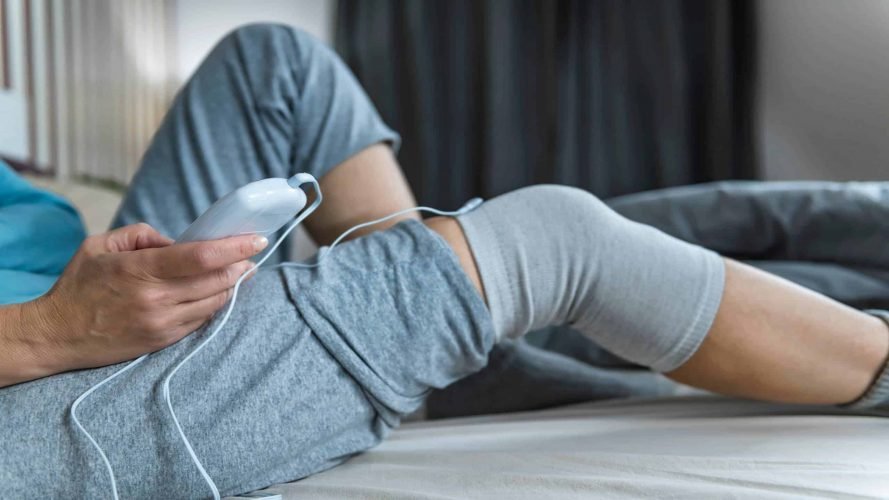Suffering from chronic neck, shoulder, or back pain is a sad reality for most people. The amount of time we spend behind a desk, a steering wheel, or on our phones is extraordinary! While spending days hunched over desks or looking down at our mobile devices isn’t the only reason for poor posture, these sure do have a considerable impact on our spinal alignment and how we carry ourselves. Not to mention, breaking the habit of bad posture isn’t an easy feat.
Luckily, there is a light at the end of this misaligned tunnel! Enter the posture corrector! This is one of the most effective ways to correct bad posture, strengthen your back muscles, and provide proper spinal support. Alternatively, you can incorporate spinal yoga stretches alongside your posture corrector or even combine your posture correction process using an inversion table. A good combination of elongating your spine and alleviating back pain!
Our Top Pick
Best Overall Posture Corrector
The Truweo posture corrector is our top pick when it comes to the best overall posture correcting experience. It provides a great range of motion, support, and pain relief to your spine. While also offering comfort and durability for everyday use.
Best Value For Money Posture Corrector
The Edila posture corrector gets our vote for the best value for money. Not only is it easy to use and comfortable to wear, but it also offers good spinal support and helps with back and shoulder pain relief.
Best Budget Posture Corrector
For the bargain hunters, we can recommend the Comezy posture corrector. At a very affordable price, it still provides a surprising amount of support, comfort, and pain relief. A worthy budget option if you’re wanting to work on your posture without breaking the bank!
Best Posture Corrector for Women
The Marakym Posture Corrector smart and good-looking posture corrector is a must for any fashionista! Although this posture corrector is unisex, it is definitely a contender for the best posture corrector for women. The thin, sleek design is perfect for wearing underneath delicate garments without looking bulky and out of place.
Best Posture Corrector for Men
The Mercase Posture Corrector has a special design. It has two straps around the back and waist. These straps provide strong support to your waist and your back, stabilizing and supporting your shoulders, chest, and back. It is also perfect for those with broader shoulders or a larger upper body as it covers your entire upper back.
Below we will go through some of the best posture correctors available, as well as what you need to take into account before making a purchase. We’ll also explain some of the effects that poor posture can have on your health and what additional exercises you can do to help alleviate and prevent neck, shoulder, and back pain due to bad posture.
The 10 Best Posture Correctors
If you’re not sure what to look for when it comes to posture correctors, fear not. This list summarizes all the need-to-know info to help you make your choice!
1. Truweo Posture Corrector

If you’re looking for the best posture corrector, then look no further than the Truweo posture corrector! Designed to offer clavicle posture support, reduce shoulder and neck pain, and improve your breathing while also prioritizing the wearer’s comfort, this is a good investment, according to us!
The broad shoulder straps ensure a snug fit that doesn’t bite into your skin. Another critical factor of this posture corrector is that it doesn’t forcibly restrict your movement as other braces tend to do, again focusing on the wearer’s comfort. This posture corrector will fit chest sizes 30″ – 44″.
Its more rugged appearance could suggest that it might be difficult to wear this underneath clothing, but luckily this is not the case! You can wear this underneath your corporate attire. This is also probably the best posture corrector for men, as the wide straps and spinal brace would be a more comfy option for people with broader or more muscular shoulders and torsos in general.
Made from robust and breathable neoprene material, it is an excellent choice if you lead an active lifestyle or are very mobile throughout your day. The padding is explicitly designed to help protect your skin against chafing and irritation. Reinforced with double stitching on the straps, ensure that the posture brace remains strong and durable throughout day-to-day use.
Initially, start wearing this posture corrector for 20-30 minutes a day and gradually increase to 1-2 hours daily.
This corrector is the top choice when it comes to comfort and pain relief—providing an impressive range of motion while fully supporting your spine.
2. Gearari Posture Corrector
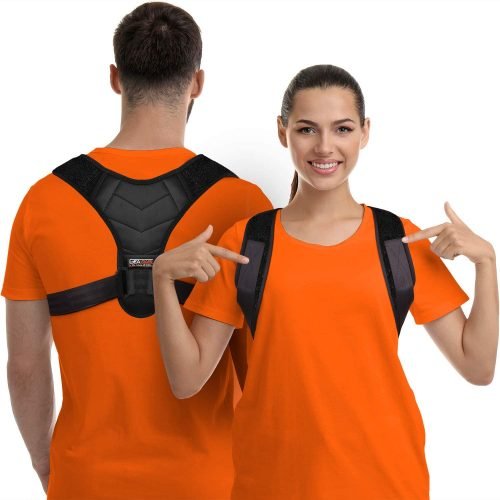
The Gearari posture corrector is perfect for those looking for a back brace that’s a little more heavy-duty. Its ergonomic design provides support and comfort while straightening out your neck, shoulders, and back, providing you with added strength and comfort.
Made from high-quality, ultra-durable materials, it is perfect for wearing underneath your clothing and for long periods. Designed to be lightweight, soft, and porous, the brace offers constant ventilation that minimizes chafing. For those with an active lifestyle, movement in this brace is not restricted, so feel free to wear it on the go! This posture corrector will fit chest sizes 27″ – 42″.
Start wearing it for 15 minutes, working up to 2 hours each day for two weeks. It is essential to give your body and muscles time to adjust, so initially, do not wear the belt for too long in the beginning.
The Gearari posture corrector shouldn’t be overlooked as it’s excellent value for money, well designed, and highly effective for spinal rehabilitation. The sizing options are a bit limited, so this might not be the best fit for everyone.
3. FY Posture Corrector
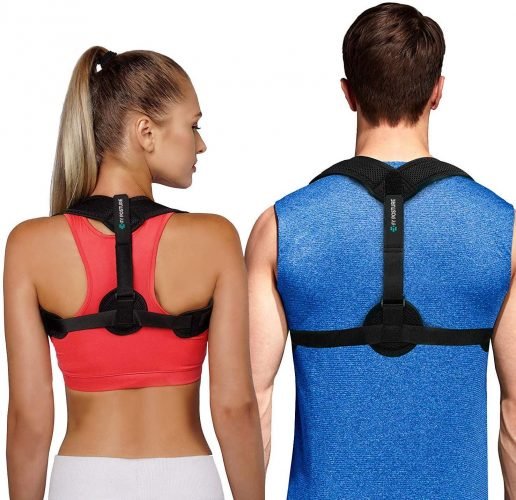
This sleek posture corrector reminds you to straighten up by tightening and pulling back your shoulders the moment you start slouching. This engages your core muscles when you straighten up and activates your body’s natural muscle memory.
Its simplistic and discrete design makes it comfortable to wear underneath your everyday clothes. This corrector is designed to last through regular use as it is made from lightweight, breathable compound material. The adjustable straps located on the front of this posture corrector make it easy to put on and fit without additional help. Padded straps and armpit pads provide a comfy fit with no chaffing. You should note that the straps tend to twist over a long period of use, especially if you’re of a larger build. If this happens, it can make it very uncomfortable to wear. This posture corrector will fit chest sizes 25″ – 53″.
Start by wearing this posture corrector for 15 – 20 minutes per day for the first two weeks. After that, gradually adding 15 minutes each day. By the 3rd week, the posture corrector can be worn up to 2 hours per day or whenever you need to wear it. This corrector is also ideal for wearing for users who have serious posture ailments such as Kyphosis, Lordosis (APT), Kyphoscoliosis, or a winged scapula. It also helps relieve pressure on your back during pregnancy, which is a welcomed comfort to all expectant moms!
Fy Posture also offers a free E-Book guide of tips, exercises, and videos to help you correct your posture within one month.
4. ComfyBrace Posture Corrector

Orthopedically designed and created to correct bad posture and alleviate chronic back pain, the ComfyBrace posture corrector is there to do the job at an affordable rate. This simplistic posture corrector is made from Neoprene material, known to be lightweight and durable. Its wide straps ensure a comfortable and supportive fit over your shoulders and under your arms. In terms of aesthetics, this brace is attractive, and the high-end stitching provides added strength. Also, the high-quality material itself feels soft to the touch and won’t cause any skin irritation. For those who are a little more active throughout their day, the porous cloth material helps prevent perspiration! A blessing during the warmer summer months.
This posture corrector will fit chest sizes 30″ – 43″.
You can start by wearing this back straightener for 5-10 minutes per day and then extend the time to an hour or two at a time. Feel free to wear it under your clothing, as it’s discrete enough to go undetected!
This corrector is perfect for both men and women, simple to use, looks good, and fits comfortably. Initially, it might be a little bit uncomfortable under the arms when you first start wearing it, but as your posture improve, this discomfort disappears.
5. Schiara Posture Corrector
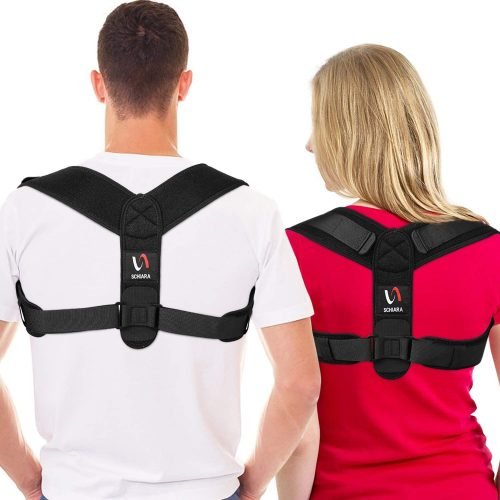
A quick way to curb slouching and correct your posture is to use the Schiara posture corrector. This back brace will quickly help realign your spine and effectively help reduce back shoulder and neck pain due to bad form. If you want to strengthen your muscles and restore mobility, then this posture corrector is a good option!
The back brace is made from a breathable material, and it’s comfortable enough to be worn underneath your clothing. Fully machine washable, this lightweight material is a breeze to clean. You don’t have to worry about skin irritation due to the soft and porous material.
It has to be mentioned that this corrector brace fits chest circumferences of 28″ to 43″. It is equipped with wide adjustable straps with underarm pads to protect you from chafing. Although the straps are adjustable, it should be mentioned that this brace would not be as comfortable for those with a larger torso.
Start by wearing the back brace for 20 – 30 minutes, working up to 1 hour per day for two weeks. Do this when you feel comfortable or on your chiropractic or orthopedic medic’s recommendation. Please note that it is common for the brace to feel uncomfortable for the first 3 to 4 days, but as your posture starts improving, so will the level of comfortability.
Suppose you’re looking for a more sturdy posture corrector that will strengthen your back muscles, improve balance and flexibility, and better your posture. In that case, the Schiara posture corrector is a good choice. The wise back straps alleviate pressure and ensure a comfy fit, while the full adjustability of the brace will pull your shoulders back without hurting you.
6. Edila Posture Corrector

If you’re stuck behind a desk for most of your day, and would just like a straightforward solution to correcting your posture, then you might want to consider the Edila posture corrector. It has a very minimalistic design, nothing over the top, and does exactly what it’s supposed to!
Its discrete and lightweight design makes it comfortable enough to wear over or under your clothes. The brace is extremely easy to put on due to its flexible yet durable neoprene material. Strong padded straps and metal brackets offer an extra sense of support and durability.
This back brace mainly fits over your upper back area, offering support to your neck and shoulders. The wide, padded straps are tightened under your arms. You do get added cushions that you can place on the straps under your armpits, but just be aware that this can be a bit uncomfortable. This posture corrector will fit chest sizes 28″ – 52″.
You can begin to wear your posture corrector for 10-15 minutes a day and gradually increase to 1-2 hours daily.
If you’re looking for a back brace to help improve your posture throughout the day, then this is one of the most affordable, straight-to-the-point ways to do it! This product is excellent value for money when it comes to general back support and comfort. However, if you’re looking for something that will focus more on back, neck, and shoulder pain relief, this should not be your first consideration.
7. Comezy Posture Corrector
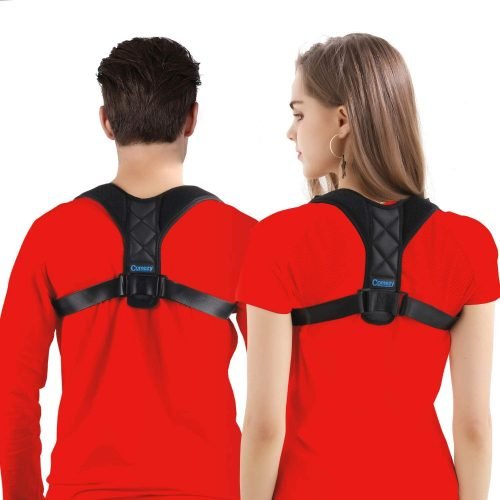
The most affordable on our list, this back brace is also a good option to consider if you’re looking for a general posture corrector. The Comezy posture corrector is designed to align your spine and strengthen your core and back muscles while alleviating pressure on your armpits and still providing the freedom to move as you like.
Unlike most of the previous mentions on this list, this posture corrector has thin shoulder straps. In some cases, this can dig into your skin or armpits, especially if you’re wearing it for extended periods or if you are of a bigger build. So just take note of this.
Although this back posture corrector is on the more affordable end of the spectrum, it offers many of the same features as its more expensive counterparts. Its lightweight design enables it to be worn underneath your clothes, and it is easily adjustable and made from breathable fabrics. This also makes it comfortable to wear during normal day-to-day activities. Suitable to be worn by men, women, and also teenagers. This posture corrector will fit chest sizes 40″ – 48″.
You can begin to wear your posture corrector twice a day for 1 hour. After the adjustment period, it can be worn once every day for an hour.
Overall this is a decent back brace for its price range. It looks nice and well put together. It is soft to the touch and aids in reducing the amount of time you spend slouching. However, this product is better used as a reminder to straighten up and improve your posture rather than for full-on spinal support. This corrector is not the best option for users with more severe posture problems and back ailments.
8. Copeaky Posture Corrector
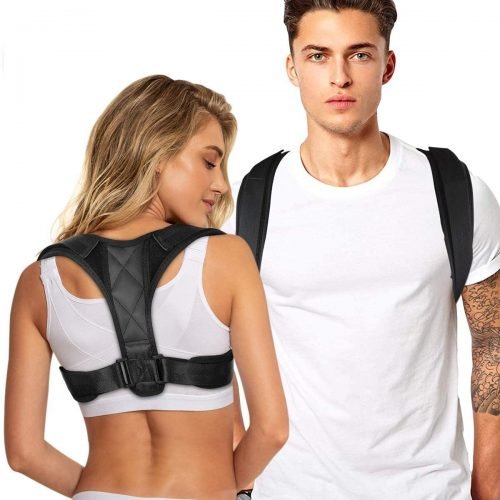
Another affordable back brace is the Copeaky posture corrector. A bit more sturdy in design, this is a perfect option for anyone struggling with back, shoulder, and neck pain due to extended periods of sitting hunched over behind a desk. The solid upper back brace helps alleviate back and neck problems such as rounded shoulders, neck and shoulder pain, and a hunchback.
Like the previous back aids, this posture corrector is also made of strong neoprene material. This means that the brace is lightweight, breathable, and skin-friendly. As always, this brace is also designed to be discreet and can comfortably be worn underneath your clothing. The straps are wide and double stitched, ensuring durability for everyday wear. 37″ – 45″.
You can wear this posture corrector daily. It is easy to dress and is entirely adjustable, which ensures a proper and comfortable fit. Start with 10 – 20 minutes per day. As your posture improves, add 10 minutes to your time daily.
The Copeaky posture corrector is well adept at helping correct posture and at alleviating neck and shoulder pain. Fitted with ergonomic design molds, it fits comfortably, offers cartilage support and overall spinal wellbeing. If you have low to moderate posture ailments, then this would be a good investment!
9. Mercase Posture Corrector
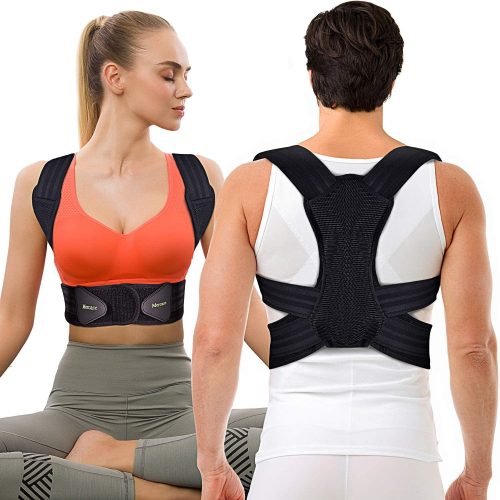
This double back strap posture corrector is designed to provide more effective spinal support and spinal realignment. The extra-wide strap around your middle helps prevent slouching while also relieving neck, shoulder, and back pain due to poor posture.
Made from durable, high-quality fabric, it’s great for everyday use. It offers two adjustable shoulder patches that you can move up or down to accommodate different body shapes and prevent the straps from digging into your skin. The high-end Nylon mesh material located on the back strap is light and airy, ensuring that your skin will not get irritated due to excess sweat. The shoulder strap is fully elastic, which allows the wearer to adjust the tightness of the posture corrector to their comfort level.
This back brace has a unique design which has two straps around the back and waist. These straps provide vital support to your abdomen and back, stabilizing and supporting your shoulders, chest, and back. It is also perfect for those with broader shoulders or a larger upper body as it covers your entire upper back. Comfortable fit for chest sizes 23″ to 50″.
You can start by wearing this back brace for 20 – 30 minutes per day. As your body adjusts, gradually work your way up to 1 – 2 hours per day. Take it easy and go at your own pace. The back brace will help to improve your posture by activating muscle memory and training your body to straighten up on its own, without additional support. Please take note that it is not recommended to sleep with this back brace. Wearing it for longer than the prescribed time can lead to blood circulation issues.
If you’re looking for a back brace that is a bit more robust in appearance, durable but still fits comfortably, then this should be one of your top considerations. It is very well designed and offers a lot of comfort and support, especially for users with larger upper bodies. The adjustable Velcro straps are great, as you can still use this belt as you gain or lose weight.
10. Marakym Posture Corrector
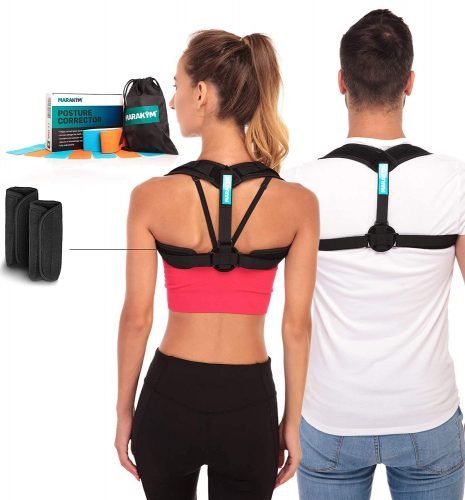
This intelligent and good-looking posture corrector is a must for any fashionista! Although this posture corrector is unisex, it is a contender for the best posture corrector for women. The thin, sleek design is perfect for wearing underneath delicate garments without looking bulky and out of place.
This back brace is designed explicitly to prevent nerve damage and tightening of muscles due to bad posture. The back strap is thin and discrete, while the shoulder straps are a bit wider, offering extra support and comfort. Made from neoprene, it goes without saying that this posture brace is made from robust and high-quality material. Perfect for regular, everyday wear.
Marakym also offers a bonus kinesiology tape, underarm pads, and a sleek carrier bag with the purchase of this posture corrector for those who prefer extra accessories with their purchases, ensuring that you have everything you need to get the most out of your back brace. Comfortable fit for chest sizes 28″ to 48″.
Start out wearing the back brace for 30 – 40 minutes during the first week. After 1 to 2 weeks, increase the length of wear by 20 – 30 minutes every day. This is entirely dependent on your level of comfort. Note that you may experience a tiny bit of discomfort or tension in your back during the first week as your posture is being corrected and muscles are being engaged.
This sleek and modern posture corrector is highly recommended, not only for its aesthetic design, strength, and durability but also for its added effort to educate the wearer on proper posture and how to achieve it. The thin straps might not be comfortable for everyone, and you should note that extra help is needed to put the brace on correctly. Other than that, this is a good investment!
Negative Effects Due to Poor Posture
In some cases, a bad accident, injury, or disease can be to blame for a less than desirable posture, but usually, it develops over time due to bad habits and weak muscle form. The latter of which can be completely avoided!
The scary part is that bad posture can have a dire long-term impact on the shape of your spine and your overall health and wellbeing.
Digestion Problems Due to Poor Posture
Sitting at a desk for long periods of time will make it difficult to continuously keep your back straight. It’s very hard not to let your shoulders and neck slouch over your chest. This position places a lot of pressure on your digestive tract. Over time this can negatively impact your metabolism and your body’s ability to process food correctly.
Dr. Kyle Staller, a gastroenterologist at Harvard-affiliated Massachusetts General Hospital explains: “Slouching puts pressure on the abdomen, which can force stomach acid in the wrong direction.” According to Dr. Staller “… some evidence suggests that transit in the intestines slows down when you slouch. In my opinion, it probably does play a small role.”
Increased Risk of Cardiovascular Disease
Bad posture can change the alignment of your spine and constrict blood vessels. This can then affect the oxygen and nutrient supply in your body, leading to blood clots and deep vein thrombosis. All of which severely increases the risk of developing cardiovascular diseases if left untreated.
Bad Posture and Chronic Back Pain
Chronic back pain is probably the most common side effect of bad posture. This is mostly due to disk degeneration, when the disks between the vertebrae thin out and lose their cushioning, or the excessive pressure endured by the spine as a result of poor posture and spinal support.
Subluxations as a Result of Poor Posture
This happens when the spinal column becomes misaligned, affecting the overall integrity and strength of the spine. When this happens, it can cause a lot of stress and irritation on your back and surrounding spinal nerves.
Nerve Constriction Due to Bad Posture
When the skeletal system comes into contact with surrounding nerves, due to the spine and bones changing position, nerves can sometimes become “pinched”. These pinched nerves can cause discomfort and serious, inhibiting neck, and back pain. It is also common to feel pain in seemingly unrelated areas of the body as well.
Taking all of this into consideration, it is clear to see that bad posture can lead to far more concerning ailments. Therefore it is wise to be aware of the impacts and how to go about preventing them as soon as possible.
Interesting Facts About Poor Posture
lost work days annually due to back pain
of the population will experience back pain at some time in their lives
is spent annually, by Americans, on health care costs for back pain
Things to Consider When Buying a Posture Corrector
When choosing a posture corrector, it is important to consider your individual needs.
Size
One size fits all isn’t necessarily the way to go when it comes to posture correctors, as people tend to have quite an array of different body measurements. Take into account length, body build, and muscle tone; also whether or not the corrector is made from a stretchable material.
Material
As mentioned above, it’s a good option to consider the material of the posture corrector. The most common types are spandex, lycra, latex, rubber, and cotton.
If you want something durable and low maintenance, then you should go for spandex, lycra, or latex correctors. However, keep in mind that it is very common for people to experience allergic skin reactions to these materials when exposed to it for extended periods.
If you’re looking not to break the bank, then rubber correctors are a good way to go. Not as strong and durable as the material mentioned above, it will still hold up long enough for you to get your money’s worth. As a side note, rubber usually does acquire a smell over time, so keep this in mind before making your purchase.
Cotton is a durable and low maintenance material. It’s washing machine friendly and offers a soft comfortable fit. However, cotton does not stretch. They are sweat absorbent though, making this material excellent for sporting purposes and active work.
Support and Comfort
When considering comfort, look for a model that has adjustable straps and elasticized sections that would properly suit your body’s frame. As mentioned above, also consider the material that will not irritate your skin.
Adjustability
This will make a noticeable difference in your experience while wearing a posture corrector and avoiding discomfort. A good posture corrector should be adjustable to fit your body and shape perfectly.
Ease of Use
Of course, a posture corrector should be simple and efficient to put on and to take off. As well as easily adjustable, as mentioned above. Dealing with neck, shoulder, and back pain on a regular basis is punishment enough, you shouldn’t have to strain yourself any further in order to get the corrector on or off.
If you’re not one for flashy features and gimmicks, make sure to look for something that is functional and straightforward to use.
Stretches and Exercises To Improve Posture
Because most Americans spend about 13 hours of their day sitting, it’s no wonder that so many people suffer from chronic back pain and terrible posture. Fortunately, there are a few things you can do to improve and maintain your posture and relieve back pain and muscle tension.
Apart from posture correctors and physio, stretching and certain yoga poses will do wonders if you need a little spinal relief and realignment. Below are just a few stretches and exercises you can try to improve your posture.
Child’s Pose
Level: Beginner
Muscles worked: Shoulders, core, and back
Lengthens and stretches the spine. Great for combatting bad posture habits.
Standing Forward Fold
Level: Beginner
Muscles worked: Neck, shoulders, and hamstrings
Releases tension in the neck and shoulders by stretching the hamstrings and opening the hips
Cat Cow Pose
Level: Beginner
Muscles worked: Back, chest and abdominals
Stretches and massages the spine. Promotes blood circulation and relieves tension in your torso, neck, and shoulders.
Thoracic Spine Rotation
Level: Intermediate
Muscles worked: Back, chest and abdominals
Improves mobility in the torso, while also giving the thoracic spine a good stretch. Reduces stiffness in the lower back. Thoracic spine mobility is very important as it helps with loosening the tightness in the lower back muscles.
Frequently Asked Questions
Why Is Good Posture Important?
Good postural alignment is important as it helps you to perform various daily tasks without running the risk of injuring yourself or suffering from ligament and muscle fatigue. Not only does good posture reduce stress and strain on your spine, but it makes you look taller and more self-assured.
How Tight Should I Wear My Posture Corrector?
Using a posture corrector is crucial and will determine your body’s ability to adjust to the proper posture and to train the muscles to stay in the appropriate position without additional help. When wearing a posture corrector, certain factors are usually taken into account; the type and level of injury and the wearer’s physical characteristics and body build.
The corrector should not be too tight, as it will inhibit proper blood flow and circulation and will cause discomfort and pain. The corrector should be just tight enough to push back against you when you try to slouch.
If it is being worn to help recover from an injury, it should be adjusted to accommodate the injury and the level of pain experienced.
If the posture corrector is being worn simply for the purpose of attaining better posture, the tightness of the brace should be determined by the level of posture correction that is required.
Furthermore, take into account the wearer’s personal characteristics; body type, age, gender, and bone structure. These all will play a role in the proper level of tightness that is required from your posture corrector.
How Do Posture Correctors Work?
Simply put, posture correctors counteract our tendencies to round our shoulders and hunch our backs when we sit or stand for extended periods. The rounding of the shoulders causes the soft tissue across the chest and back adapts to this position and becomes tight. When weaning a posture brace, the muscles that have become tight over time will be pulled back and stretched into their natural position, which will give you the proper, healthy posture that you need.
Posture correctors are clinically proven to work on improving spinal misalignment. However, they should be used as tools to help you improve your posture, and not just as the sole solution. Combined with proper spinal stretches and exercises, your results will be by far more significant.
Can Seniors Wear Posture Correctors?
The short answer to this is, yes!
Just keep in mind when choosing a posture corrector for a senior; the material should be soft, not abrasive, as their skin is very thin. The corrector should be lightweight and comfortable to wear. And most important, it should be easy for them to put on and take off. Many elderly suffer from arthritis so a posture corrector that is difficult to put on would not be a good choice.
How Long Will It Take To Correct My Posture?
The process of spinal realignment can take anywhere from a few days to weeks and even months. Depending on the reason for poor posture and the severity of the spinal misalignment. On average it takes about two weeks to see a noticeable difference.
When wearing a posture aid, you will usually be able to feel a difference in the first 10 – 15 minutes, as your back muscles are being gently stretched and your spinal column is being supported.
Conclusion
At some point in our lives, we will struggle with bad posture or posture-related ailments. Whether it be due to injury, disease, lifestyle, age, or genetics; it’s a daily reality for many. Luckily posture correctors enable us to remedy this problem by providing adequate spinal support and pain relief. In some cases, these posture correctors even contribute to spinal realignment! If you’re looking for something to help with mild posture problems, extra support when sitting for extended periods, or recovering from a more serious back or shoulder injury, you will definitely be able to find a posture corrector that will accommodate your individual needs in the best and most comfortable manner possible!
Our Top Pick



